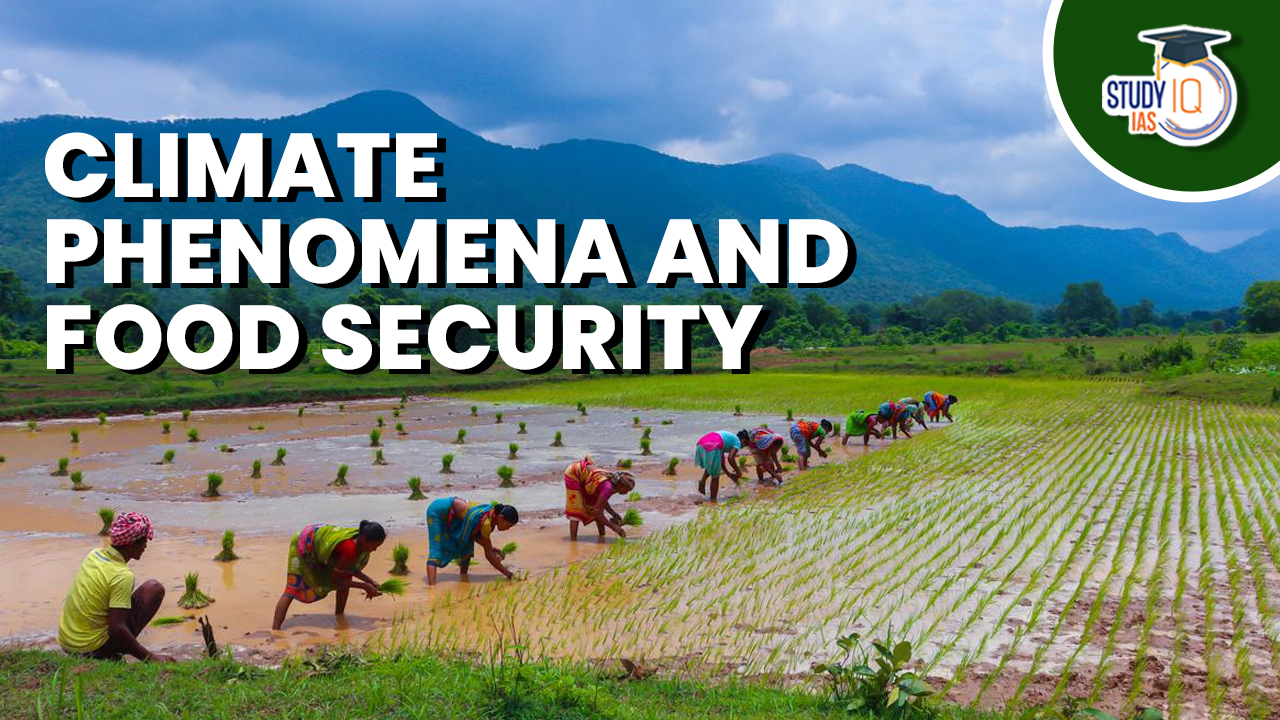Table of Contents
Context: From Western disturbances persisting late into the summer to the intensification of El Niño events, climate change is posing challenges to India’s food security and the sustainability of its agricultural systems.
Impact of Western Disturbances on India’s Food Security
- Western disturbances are weather systems that typically bring moisture from European seas to the western Himalaya and parts of northern India during the winter and spring.
- However, in the current year, these Western disturbances remained active into the late summer season. This unusual and extended presence has disrupted the region’s weather patterns.
- Impact on Monsoon: The extended presence of Western disturbances has overlapped with the southwest monsoon, potentially affecting the monsoon’s onset and progression.
- This disruption can have significant consequences for agriculture as the monsoon plays a crucial role in Indian agriculture.
- Also, the prolonged Western disturbances have led to widespread destruction of infrastructure and loss of life due to landslides and flooding in the western Himalaya and northern India.
Impact of El Niño on India’s Food Security
- Currently, El Niño conditions are prevailing in the eastern and central tropical Pacific Oceans and are expected to intensify further in the coming months.
- Impact of El Niño on Indian Monsoon:
- Weakening of Monsoon Winds: During El Niño years, the trade winds across the Pacific weaken, reducing their ability to push moisture-laden air towards the Indian subcontinent. As a result, the monsoon winds over the Indian Ocean and the Arabian Sea weaken, leading to a decrease in the overall strength of the monsoon.
- Shift in Rainfall Patterns: The regions that typically receive abundant rainfall during the monsoon season may experience below-average rainfall, while regions that usually receive less rainfall may receive more. This spatial redistribution of rainfall can have significant implications for agriculture, water resources, and ecosystems.
- Delayed Onset and Early Withdrawal: El Niño events can delay the onset of the monsoon season in India. Similarly, El Niño can lead to an early withdrawal of the monsoon, shortening the overall duration of the rainy season.
- El Niño and the northeast monsoon:
- Studies have found that 43% of heavy rainfall events in the northeast monsoon (including the 2015 Chennai floods that caused widespread devastation) coincided with an El Niño.
- Impacts on Food Security:
- Reduced Crop Yields: As Indian agriculture is mostly rainfed, deficiency in rainfall due to El Niño conditions can lead to drought conditions in some regions, reducing crop yields.
- In the 2015-2016 El Niño year, for example, soybean production in India declined by 28% from the average of the preceding years.
- Water Scarcity: El Niño can contribute to water scarcity by reducing precipitation and depleting water sources. This can affect irrigation systems, which are essential for agriculture in many parts of India.
- Impact on Livestock: Reduced availability of water and forage due to El Niño-related droughts can harm livestock, affecting dairy and meat production.
- Food Price Inflation: Reduced crop yields and potential shortages can lead to food price inflation.
- Nutritional Impact: Reduced crop production can affect the availability of diverse and nutritious foods, potentially leading to nutritional deficiencies, especially among vulnerable populations.
Way Forward
- Crop Diversification: Emphasize reducing dependence on water-intensive crops, such as by promoting the cultivation of millets and other less water-demanding crops. This diversification can enhance the resilience of food systems to climate phenomena like El Niño.
- Alternative Crop Varieties: Encourage the adoption of alternative crop varieties, including those with shorter growing cycles, which can better adapt to changing climate conditions and reduce vulnerability to extreme weather events.
- Early Warning Systems: Develop and enhance early warning systems for extreme weather events, both heavy rainfall and droughts. This can help farmers and policymakers prepare for and respond to climate-related challenges.
- Policy Support: Ensure that appropriate policies are in place to manage and allocate saved water effectively, such as recharging depleted aquifers and restoring ecological flows in rivers.
- Community Engagement: Foster community engagement and participation in sustainable water-sharing practices and ecological conservation efforts.
- Climate-smart agriculture: It plays a vital role in how we respond to the challenges posed by climate change in the agricultural sector. It is an integrated approach to managing landscapes—cropland, livestock, forests and fisheries–that address the interlinked challenges of food security and climate change.
What are Western Disturbances (WDs)?
- About: WDs are extratropical storms that originates in the Mediterranean region which brings sudden winter rain to the north-western parts of the Indian sub-continent.
- Origin: WDs originate in the Caspian Sea or the Mediterranean Sea as extra-tropical cyclones.
- Travelling path: They gradually travel across the middle-east from Iran, Afghanistan and Pakistan to enter the Indian sub-continent.
- Important characteristics:
- They are a non-monsoonal precipitation pattern which is driven by the westerlies.
- These extratropical storms are a global phenomenon. They may happen during any season, not necessarily in monsoon.
- This phenomenon usually carries moisture in the upper layer of the atmosphere, unlike their tropical counterparts where the moisture is carried in the lower layer of atmosphere.
- The western disturbances are embedded in the mid-latitude subtropical westerly jet stream.
- They travel at speeds up to 12 m/s (43 km/h; 27 mph).

About El Niño–Southern Oscillation (ENSO)
- The ENSO is a recurring climate pattern involving changes in the temperature of waters in the central and eastern tropical Pacific Ocean.
- On periods ranging from about three to seven years, the surface waters across a large swath of the tropical Pacific Ocean warm or cool by anywhere from 1°C to 3°C, compared to normal.
- This oscillating warming and cooling pattern, referred to as the ENSO cycle, directly affects rainfall distribution in the tropics and can have a strong influence on weather across the world.
- ENSO has three phases: El Niño, La Niña, and neutral, which are associated with different temperature and atmospheric conditions.
- El Niño occurs when the surface water temperature in the eastern Pacific Ocean becomes warmer than usual, and this warming can last for several months to a few years.
- La Niña occurs when the surface water temperature in the eastern Pacific Ocean becomes cooler than usual, and this cooling can also last for several months to a few years.
- Neutral conditions occur when the sea surface temperatures in the eastern Pacific Ocean are close to average, with no significant warming or cooling.


 TNPSC Group 4 Admit Card 2025 Out at tnp...
TNPSC Group 4 Admit Card 2025 Out at tnp...
 Species Added to India's Flora and Fauna...
Species Added to India's Flora and Fauna...
 Daily Quiz 02 July 2025
Daily Quiz 02 July 2025





















